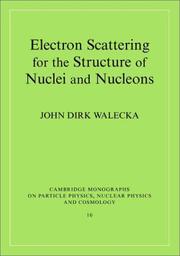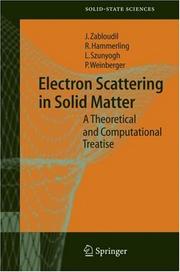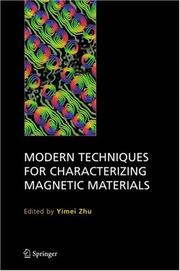| Listing 1 - 6 of 6 |
Sort by
|

ISBN: 1107120055 1280429666 9786610429660 0511175167 0511018746 0511155336 051130384X 0511535015 0511050089 9780511018749 9780511535017 9780511034831 0511034830 9780511155338 9780511050084 9780521780438 0521780438 9780521018395 0521018390 9780511175169 9781280429668 Year: 2001 Publisher: Cambridge ; New York : Cambridge University Press,
Abstract | Keywords | Export | Availability | Bookmark
 Loading...
Loading...Choose an application
- Reference Manager
- EndNote
- RefWorks (Direct export to RefWorks)
The scattering of high-energy electrons from nuclear and nucleon targets provides a microscope for examining the structure of these tiny objects. The best evidence we have on what nuclei and nucleons actually look like comes from electron scattering. This 2001 book examines the motivation for electron scattering and develops the theoretical analysis of the process. It discusses our current theoretical understanding of the underlying structure of nuclei and nucleons at appropriate levels of resolution and sophistication, and summarizes present experimental electron scattering capabilities. Only a working knowledge of quantum mechanics and special relativity is assumed, making this a suitable textbook for graduate and advanced undergraduate courses. It will also provide a valuable summary and reference for researchers already working in electron scattering and other areas of nuclear/particle physics.
Electrons --- Nuclear structure. --- Structure, Nuclear --- Nuclear physics --- Electron-positron scattering --- Electron scattering --- Scattering (Physics) --- Scattering.
Book
ISBN: 9781009290616 9781009290579 9781009290593 Year: 2022 Publisher: Cambridge : Cambridge University Press,
Abstract | Keywords | Export | Availability | Bookmark
 Loading...
Loading...Choose an application
- Reference Manager
- EndNote
- RefWorks (Direct export to RefWorks)
The scattering of high-energy electrons from nuclear and nucleon targets provides a microscope for examining the structure of these tiny objects. The best evidence we have on what nuclei and nucleons actually look like comes from electron scattering. This 2001 book examines the motivation for electron scattering and develops the theoretical analysis of the process. It discusses our theoretical understanding of the underlying structure of nuclei and nucleons at appropriate levels of resolution and sophistication, and summarizes experimental electron scattering capabilities. Only a working knowledge of quantum mechanics and special relativity is assumed, making this a suitable textbook for graduate and advanced undergraduate courses. It will also provide a valuable summary and reference for researchers already working in electron scattering and other areas of nuclear and particle physics. This text has been reissued as an Open Access publication on Cambridge Core.
Electrons --- Nuclear structure. --- Scattering. --- Structure, Nuclear --- Nuclear physics --- Electron-positron scattering --- Electron scattering --- Scattering (Physics)

ISBN: 1280346701 9786610346707 3540270019 3540225242 3642061389 Year: 2005 Publisher: Berlin ; New York : Springer,
Abstract | Keywords | Export | Availability | Bookmark
 Loading...
Loading...Choose an application
- Reference Manager
- EndNote
- RefWorks (Direct export to RefWorks)
Addressing graduate students and researchers, this book gives a very detailed theoretical and computational description of multiple scattering in solid matter. Particular emphasis is placed on solids with reduced dimensions, on full potential approaches and on relativistic treatments. For the first time approaches such as the Screened Korringa-Kohn-Rostoker method that have emerged during the last 5 – 10 years are reviewed, considering all formal steps such as single-site scattering, structure constants and screening transformations, and also the numerical point of view. Furthermore, a very general approach is presented for solving the Poisson equation, needed within density functional theory in order to achieve self-consistency. Going beyond ordered matter and translationally invariant systems, special chapters are devoted to the Coherent Potential Approximation and to the Embedded Cluster Method, used, for example, for describing nanostructured matter in real space. In a final chapter, physical properties related to the (single-particle) Green’s function, such as magnetic anisotropies, interlayer exchange coupling, electric and magneto-optical transport and spin-waves, serve to illustrate the usefulness of the methods described.
Electrons --- Solids --- Scattering. --- Effect of radiation on. --- Solids, Effect of radiation on --- Radiation --- Electron-positron scattering --- Electron scattering --- Scattering (Physics) --- Nuclear physics. --- Particle acceleration. --- Condensed Matter Physics. --- Nuclear Physics, Heavy Ions, Hadrons. --- Particle Acceleration and Detection, Beam Physics. --- Particles (Nuclear physics) --- Acceleration (Mechanics) --- Nuclear physics --- Atomic nuclei --- Atoms, Nuclei of --- Nucleus of the atom --- Physics --- Acceleration --- Condensed matter. --- Heavy ions. --- Ions --- Condensed materials --- Condensed media --- Condensed phase --- Materials, Condensed --- Media, Condensed --- Phase, Condensed --- Liquids --- Matter
Book
ISBN: 3319061453 3319061445 1322135037 Year: 2014 Publisher: Cham : Springer International Publishing : Imprint: Springer,
Abstract | Keywords | Export | Availability | Bookmark
 Loading...
Loading...Choose an application
- Reference Manager
- EndNote
- RefWorks (Direct export to RefWorks)
This book provides an insight into current research topics, focusing special attention exactly on welding issues. The presented research work demonstrates that application of synchrotron and neutron radiation in combination with other techniques enables the basic understanding of material-related processes to be extended appreciably. It also shows ways of how to improve new materials and their use in industry. Following on from the 1st workshop in 2009 at BAM Berlin, a 2nd workshop dealing with this subject matter was held in 28-30 November, 2012 in Osaka/Japan with international participation of scientists from sixteen countries. The book includes selected contributions from the various subject blocks, precisely covering issues of practical and immediately implementable benefit to industrial enterprises. Therefore, peer-reviewed papers dealing with the following topics are contained as well: - Phase transformation during welding, metallurgy and material development - Evolution and significance of residual stresses - Investigations into laser and electron beam welding.
Materials --- Electrons --- Neutrons --- Photons --- Testing. --- Scattering. --- Scattering (Physics) --- Nucleon-nucleon scattering --- Potential scattering --- Electron-positron scattering --- Electron scattering --- Materials. --- Mechanics. --- Mechanics, Applied. --- Metallic Materials. --- Solid Mechanics. --- Condensed Matter Physics. --- Applied mechanics --- Engineering, Mechanical --- Engineering mathematics --- Classical mechanics --- Newtonian mechanics --- Physics --- Dynamics --- Quantum theory --- Engineering --- Engineering materials --- Industrial materials --- Engineering design --- Manufacturing processes --- Metals. --- Condensed matter. --- Condensed materials --- Condensed media --- Condensed phase --- Materials, Condensed --- Media, Condensed --- Phase, Condensed --- Liquids --- Matter --- Solids --- Metallic elements --- Chemical elements --- Ores --- Metallurgy

ISBN: 1280612843 9786610612840 0387233954 1402080077 1441954619 Year: 2005 Publisher: Boston : Kluwer Academic Publishers,
Abstract | Keywords | Export | Availability | Bookmark
 Loading...
Loading...Choose an application
- Reference Manager
- EndNote
- RefWorks (Direct export to RefWorks)
MODERN TECHNIQUES FOR CHARACTERIZING MAGNETIC MATERIALS provides an extensive overview of novel characterization tools for magnetic materials including neutron, photon and electron scatterings and other microscopy techniques by world renowned scientists. This is an interdisciplinary book. Currently there is no existing book that describes all available techniques to characterize and to understand magnetic materials. These techniques cover a wide range of length scales and belong to different scientific communities that have little cross-discipline communication. The book will build bridges for them. It is important to note that each technique has its own advantages and drawbacks. Very often combined use of different techniques is essential to the understanding of the ever increasing complexity of modern magnetic materials at nanometer scales. The book includes, but is not limited to the following areas: Magnetic neutron scattering with 3-axis spectrometer * Small-angle neutrons scattering * Polarized neutron magnetic reflectometry * Resonant soft x-ray magneto-optic scattering * Magnetic hard x-ray scattering * Spin resolved photoemission spectroscopy * Lorentz microscopy and electron holography * Scanning electron microscopy with polarization analysis * Spin polarized low energy electron microscopy * Spin-polarized scanning tunneling microscopy * Magnetic force microscopy * Near-field scanning optical microscopy * Time-resolved scanning Kerr microscopy * Brillouin light scattering spectroscopy This reference will be a valuable resource for all graduate students, researchers, engineers and scientists who are interested in magnetic materials including their crystal structure, electronic structure, magnetization dynamics and their associated magnetic properties and underlying magnetism.
Magnetic materials --- Electrons --- Analysis. --- Microscopy. --- Scattering. --- Electron-positron scattering --- Electron scattering --- Scattering (Physics) --- Materials --- Surfaces (Physics). --- Magnetism. --- Electronics. --- Characterization and Evaluation of Materials. --- Magnetism, Magnetic Materials. --- Electronics and Microelectronics, Instrumentation. --- Surfaces and Interfaces, Thin Films. --- Condensed Matter Physics. --- Electrical engineering --- Physical sciences --- Mathematical physics --- Physics --- Electricity --- Magnetics --- Surface chemistry --- Surfaces (Technology) --- Materials science. --- Magnetic materials. --- Microelectronics. --- Materials—Surfaces. --- Thin films. --- Condensed matter. --- Condensed materials --- Condensed media --- Condensed phase --- Materials, Condensed --- Media, Condensed --- Phase, Condensed --- Liquids --- Matter --- Solids --- Films, Thin --- Solid film --- Solid state electronics --- Coatings --- Thick films --- Microminiature electronic equipment --- Microminiaturization (Electronics) --- Electronics --- Microtechnology --- Semiconductors --- Miniature electronic equipment --- Material science --- Surfaces. --- Surface phenomena --- Friction --- Surfaces (Physics) --- Tribology --- Surfaces --- Surfaces (Technology). --- Characterization and Analytical Technique. --- Surfaces, Interfaces and Thin Film.
Book
ISBN: 3319038826 3319038834 Year: 2014 Publisher: Cham : Springer International Publishing : Imprint: Springer,
Abstract | Keywords | Export | Availability | Bookmark
 Loading...
Loading...Choose an application
- Reference Manager
- EndNote
- RefWorks (Direct export to RefWorks)
This book presents the potential of the Monte Carlo (MC) technique to solve mathematical and physical problems of great complexity. This book focusses on the study of the electron-solid interaction (transport MC) and presents some physical problems related to the transport of hot electrons in solid targets using transport MC. The numerical and theoretical results are validated through a comparison with experimental results. The author also addresses methodological aspects. In particular, systematic comparisons among different calculation schemes are presented. Different expressions for the calculation of cross sections and/or stopping power and different simulation methods are described and discussed.
Physics. --- Engineering mathematics. --- Surfaces (Physics). --- Solid State Physics. --- Numerical and Computational Physics. --- Characterization and Evaluation of Materials. --- Appl.Mathematics/Computational Methods of Engineering. --- Electron transport --- Electrons --- Electron beams --- Monte Carlo method --- Physics --- Physical Sciences & Mathematics --- Atomic Physics --- Scattering --- Artificial sampling --- Model sampling --- Monte Carlo simulation --- Monte Carlo simulation method --- Stochastic sampling --- Beams, Electron --- Corpuscular theory of matter --- Engineering --- Engineering analysis --- Natural philosophy --- Philosophy, Natural --- Mathematics --- Solid state physics. --- Applied mathematics. --- Materials science. --- Electron transport. --- Monte Carlo method. --- Electron beams. --- Scattering. --- Electron optics --- Electronics --- Particle beams --- Games of chance (Mathematics) --- Mathematical models --- Numerical analysis --- Numerical calculations --- Stochastic processes --- Energy-band theory of solids --- Free electron theory of metals --- Transport theory --- Electron-positron scattering --- Electron scattering --- Scattering (Physics) --- Numerical and Computational Physics, Simulation. --- Mathematical and Computational Engineering. --- Surface chemistry --- Surfaces (Technology) --- Mathematical analysis --- Material science --- Physical sciences --- Dynamics --- Solids --- Condensed matter. --- Mathematical physics. --- Materials --- Condensed Matter Physics. --- Theoretical, Mathematical and Computational Physics. --- Characterization and Analytical Technique. --- Mathematical and Computational Engineering Applications. --- Analysis. --- Data processing. --- Physical mathematics --- Condensed materials --- Condensed media --- Condensed phase --- Materials, Condensed --- Media, Condensed --- Phase, Condensed --- Liquids --- Matter
| Listing 1 - 6 of 6 |
Sort by
|

 Search
Search Feedback
Feedback About UniCat
About UniCat  Help
Help News
News